STONE
From rough stone to cut and masoned stone, Chauvigny has been associated with the material through History. Industrially exploited since the 19th century, the quarries of the Chauvinois region have provided the material for the construction of many local monuments as well as constructions all over France and even abroad. The contemporary exploitation of Chauvigny's limestone is linked to the flint's operating chain in the Neolithic period.
-
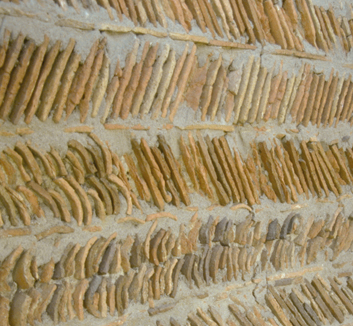 It is an oolitic limestone (from the Greek oon: egg and lithos: stone) which was deposited in the secondary era, Middle Jurassic period, Bathonian stage: about 165 million years ago, when the sea withdrew from the area. This limestone is composed of grains of different sizes; larger grains, are a sign of a rougher sea and vice versa. It is these grains that make Chauvigny's stone a high quality stone, easy to work with and resistant to bad weather, especially to frost.
It is an oolitic limestone (from the Greek oon: egg and lithos: stone) which was deposited in the secondary era, Middle Jurassic period, Bathonian stage: about 165 million years ago, when the sea withdrew from the area. This limestone is composed of grains of different sizes; larger grains, are a sign of a rougher sea and vice versa. It is these grains that make Chauvigny's stone a high quality stone, easy to work with and resistant to bad weather, especially to frost.
En revanche, However, to prevent the stone from bursting in the fireplaces, bricks or tiles could be laid to absorb the heat. This is the case at the dungeon of Gouzon (see picture) and the castle of Harcourt. -
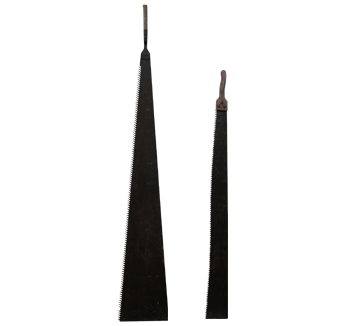 The quarrymen's tools hanging on the wall were still in use until the middle of the 19th century. Historians and archaeologists agree that the tools used in the Middle Ages and those used in modern times are similar. There was no real evolution in the tools.
The quarrymen's tools hanging on the wall were still in use until the middle of the 19th century. Historians and archaeologists agree that the tools used in the Middle Ages and those used in modern times are similar. There was no real evolution in the tools.
Blocks were generally extracted with a pickaxe, but for inaccessible areas, a spear (a large iron bar with worked ends) was used to complete the work by percussion. Once the block had been lifted, it was tipped into the quarry on crushed stone to prevent it from breaking. It was then cut to size according to requirements.
Until 1940, a "crocodile" was used for cutting. Only one quarryman could use this enormous saw because it only has one handle. In fact, when cutting stone, unlike wood, the density of the dust is such that it is impossible to move a saw back and forth. The task was therefore extremely tedious.
Then in 1940, the first stone saws appeared, initially for military purposes. The tool was heavy and bulky but saved a lot of time. -
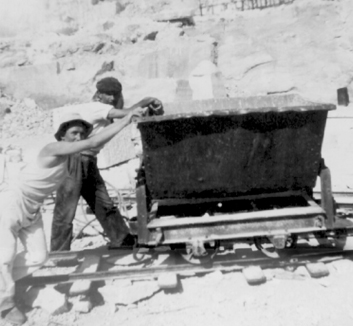 The jack was the first mechanical tool used in quarries. It was used in combination with the lever to lift blocks and put them on carts. Until the middle of the 19th century, carts were practically the only means of transportation used. It was only at the end of the 19th century that the use of railways became widespread: production became more industrial. It was easy to take the blocks to the port and distribute them by ship all over the world. In the 1920', the use of trucks made transport easier, as the railways did not reach all destinations.
The jack was the first mechanical tool used in quarries. It was used in combination with the lever to lift blocks and put them on carts. Until the middle of the 19th century, carts were practically the only means of transportation used. It was only at the end of the 19th century that the use of railways became widespread: production became more industrial. It was easy to take the blocks to the port and distribute them by ship all over the world. In the 1920', the use of trucks made transport easier, as the railways did not reach all destinations.
-
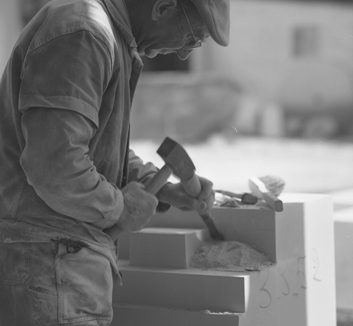 Once the stone is on the site, other professionals are involved: the stonemasons. They use the sledgehammer and the chaser to roughen the work, then chisels, "the gradine" and "the sciotte", which is a small saw used to mark the stone. The typical tool of the cutters is the "railway planer". It consists of several blades, each of which must be adapted to the shape ordered. For each shape, a suitable planer is needed, so a stonemason could have up to 50!
Once the stone is on the site, other professionals are involved: the stonemasons. They use the sledgehammer and the chaser to roughen the work, then chisels, "the gradine" and "the sciotte", which is a small saw used to mark the stone. The typical tool of the cutters is the "railway planer". It consists of several blades, each of which must be adapted to the shape ordered. For each shape, a suitable planer is needed, so a stonemason could have up to 50!
In stone work, only the visible parts are polished. The hidden areas, those in contact with the mortar, are left rough, allowing a better adhesion. -
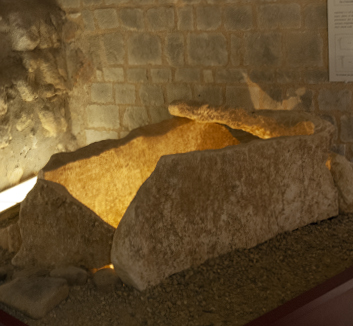 It was during the ploughing of a field on the banks of the Vienne, 6 km away from Chauvigny, that this burial site was uncovered; first by the pulling up of a slab by the plough and then by the work of archaeologists.
It was during the ploughing of a field on the banks of the Vienne, 6 km away from Chauvigny, that this burial site was uncovered; first by the pulling up of a slab by the plough and then by the work of archaeologists.
It is a Neolithic tomb dated to 5000 BC. This period marks the beginning of human settlement, agriculture and farming. Other graves were found nearby during the flooding of the Vienne River. Initially this area was chosen as a cemetery because it was high enough above the river level.
This burial is made up of slabs, carved a few hundred metres further on in a limestone area. They have an average thickness of 5 cm, which makes them very fragile and implies a well-honed technique for moving them. Inside the stone, the walls are flattened, which means that a tool, probably a flint striker, was used to hammer the stone to obtain this wall. -